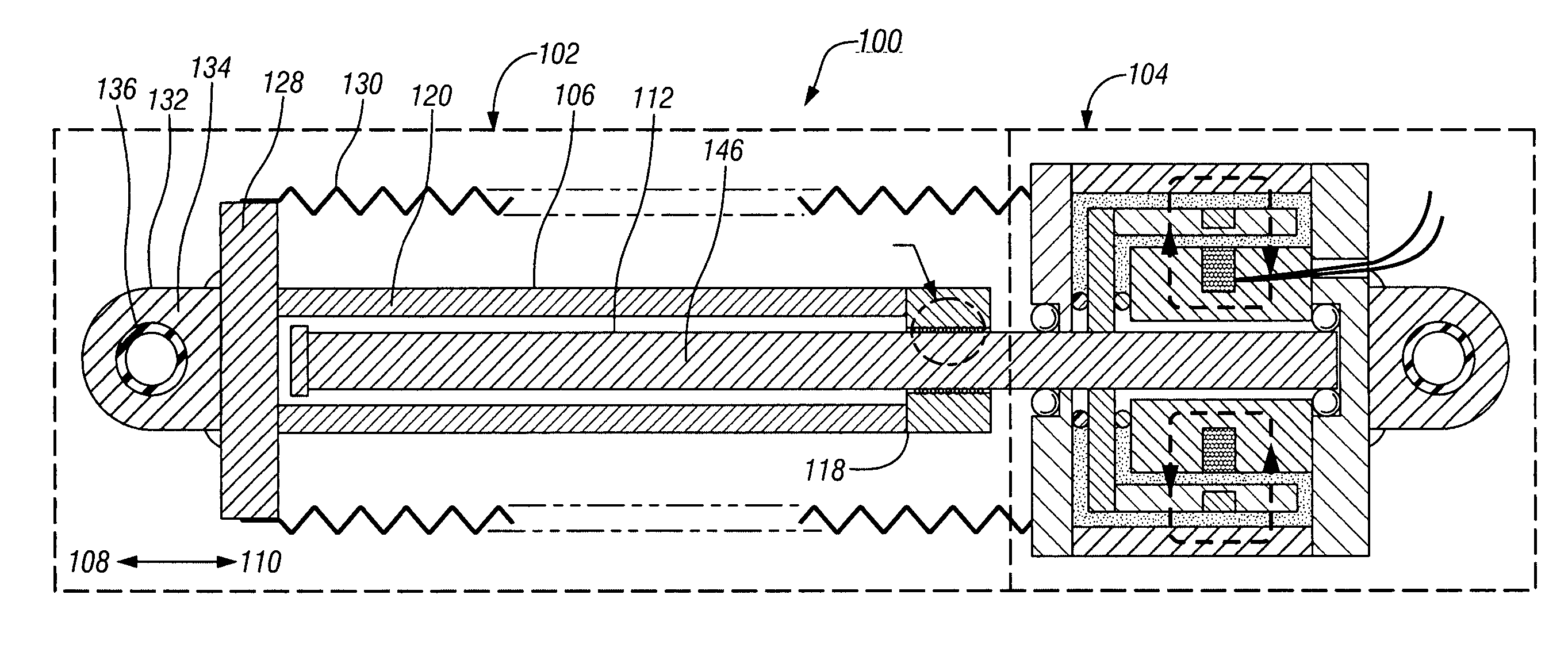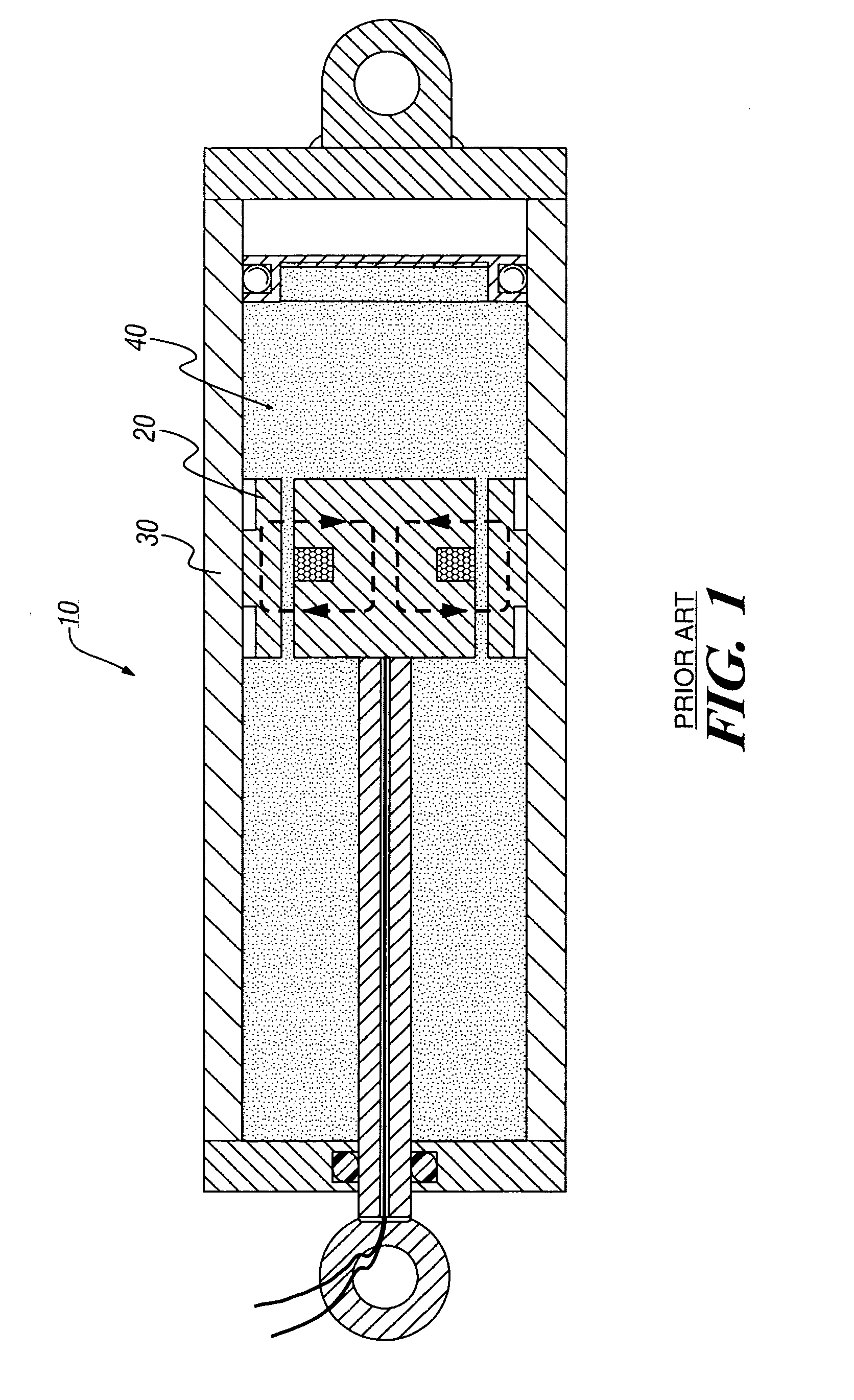Fluid damper having continuously variable damping response
a technology of damper and fluid, which is applied in the direction of shock absorber, spring/damper, vibration suppression adjustment, etc., can solve the problems of fluids that may require special handling and disposal at the end of the useful service life of the vehicle, and the difficulty of packaging the piston with an appropriate coil, etc., to achieve the effect of reducing the manufacturing cost and reducing the volume of mr fluid
- Summary
- Abstract
- Description
- Claims
- Application Information
AI Technical Summary
Benefits of technology
Problems solved by technology
Method used
Image
Examples
first embodiment
[0032] Referring to FIGS. 2-3, damping mechanism 104 is illustrated wherein hub 154 generally has the shape of a cylindrical cup that is fixed to shaft 114. In this embodiment, channel 176 has the shape of a pair of concentric cylindrical cups of different diameter which are joined by a lateral section at their rims. Channel 176 is defined and bounded generally by a portion of inner surface 170 of sidewall 168, inner surface 165 of first end 164 and outer surface 174 of hub 154; inner surface 182 of hub 154 and outer surface 184 of cylindrical core 186; and inner surface 173 of second end 172. Hub 154 preferably comprises cylindrical base 188 that is fixed to shaft 114 using known joining methods, such as an interference fit, welding, brazing, staking or other methods, and cylindrical wall 190 which extends outwardly from cylindrical base 188. Cylindrical base 188 preferably comprises a non-magnetic material, such as austenitic steel, aluminum or other non-magnetic material. Cylindr...
second embodiment
[0034] Referring to FIG. 4, damping mechanism 104 is illustrated, wherein hub 154 generally has the shape, features and construction of cylindrical cup-shaped hub 154 described above with regard to FIGS. 2-3. Outer surface 174 of hub 154 is located proximate inner surface 170 of sidewall 168 and inner surface 165 of first end 164 in spaced adjacency, such that channel 176 is formed thereby. Channel 176 is further defined by a pair of seals 198 that are located between inner surface 165 of first end 164 and outer surface 174 of hub 154 in order to retain fluid 160 within channel 176. Fluid 160 is preferably an MR fluid. When an MR fluid 160 is used, damping mechanism 104 also comprises coil 200 which in turn comprises a plurality of wire windings and may also incorporate a magnetic core in order to enhance the strength of magnetic fields 158 that may be produced by coil 200. Coil 200 may be attached and operated as described above with regard to the apparatus of FIGS. 2-3. Damping me...
third embodiment
[0035] Referring to FIG. 5, damping mechanism 104 is illustrated, wherein hub 154 generally has the shape of a cylindrical disk that is fixed to shaft 114. In this embodiment, channel 176 also generally has the shape of a cylinder which is defined generally by outer surface 174 of hub 154 and a cylindrical portion of inner surface 170 of sidewall 168. Hub 154 preferably comprises a cylindrical disk that is fixed to shaft 114 using methods such as those described above with regard to FIGS. 2-3. Hub 154 comprises a magnetic material, such as magnetic steel. Outer surface 174 of hub 154 is located proximate a cylindrical portion of inner surface 170 of sidewall 168 in spaced adjacency, such that channel 176 is formed thereby. Channel 176 is further defined by a pair of seals 198 that are located between inner surface 170 of sidewall 168 and outer surface 174 of hub 154 in order to retain fluid 160 within channel. When an MR fluid 160 is used, damping mechanism 104 also comprises coil 2...
PUM
 Login to View More
Login to View More Abstract
Description
Claims
Application Information
 Login to View More
Login to View More - R&D
- Intellectual Property
- Life Sciences
- Materials
- Tech Scout
- Unparalleled Data Quality
- Higher Quality Content
- 60% Fewer Hallucinations
Browse by: Latest US Patents, China's latest patents, Technical Efficacy Thesaurus, Application Domain, Technology Topic, Popular Technical Reports.
© 2025 PatSnap. All rights reserved.Legal|Privacy policy|Modern Slavery Act Transparency Statement|Sitemap|About US| Contact US: help@patsnap.com



